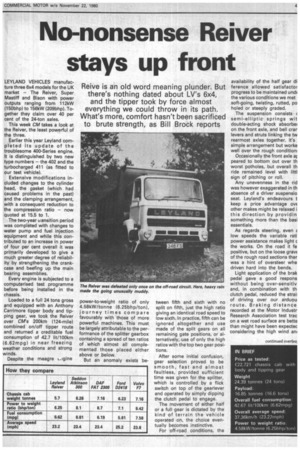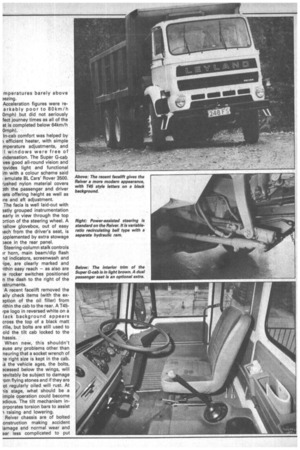No-nonsense Reiver stays up front
Page 47

Page 48

Page 50

If you've noticed an error in this article please click here to report it so we can fix it.
Reive is an old word meaning plunder. But there's nothing dated about LV's 6x4, and the tipper took by force almost everything we could throw in its path. What's more, comfort hasn't been sacrificed to brute strength, as Bill Brock reports
LEYLAND VEHICLES manufacture three 6x4 models for the UK market The Reiver, Super Mastiff and Bison with power outputs ranging from 112kW (150bhp) to 156kW (209bhp). Together they claim over 40 per cent of the 24-ton sales.
This week CM takes a look at the Reiver, the least powerful of the three.
Earlier this year Leyland completed its update of the troublesome 400-Series engine. It is distinguished by two new type numbers the 402 and the turbocharged 411 (as fitted to our test vehicle).
Extensive modifications included changes to the cylinder head, the gasket (which had caused problems in the past) and the clamping arrangement, with a consequent reduction to the compression ratio now quoted at 15.5 to 1.
The two-year isansition period was completed with changes to water pump and fuel injection equipment and while this contributed to an increase in power of four per cent overall it was primarily developed to give a much greater degree of reliability by strengthening the crankcase and beefing up the main bearing assemblies.
Every engine is subjected to a computerised test programme before being installed in the chassis.
Loaded to a full 24 tons gross and equipped with an Anthony Carrimore tipper body and tipping gear, we took the Reiver over CM's 200km (124-mile) combined on/off tipper route and returned a creditable fuel consumption of 42.7 lit/100km (6.62mpg) in near freezing weather conditions and strpng winds.
Despite the meagre Logine power-to-weight ratio of only 4.58kW/tonne (6.25bhp/ton), journey times compare favourably with those of more powerful machines. This must be largely attributable to the performance of the splitter gearbox containing a spread of ten ratios of which almost all complemented those placed either above or below.
But an anomaly exists be tween fifth and sixth with no split on fifth, just the high ratio giving an identical road speed to low sixth. In practice, fifth can be ignored altogether and use made of the split gears on all remaining gate positions, or alternatively, use of only the high ratios with the top two gear positions.
After some initial confusion, gear selection proved to be smooth, fast and almost faultless, provided sufficient time was given for the splitter, which is controlled by a flick switch on top of the gearlever and operated by simply dipping the clutch pedal to engage.
The movement of either half or a full gear is dictated by the kind of terrain the vehicle operated on, the choice eventually becomes instinctive.
For off-road conditions, the availability of the half gear di ference allowed satisfactot progress to be maintained undt the various conditions we met soft-going, twisting, rutted, po holed or steeply graded.
The suspension consists semi-elliptic springs wit double-acting shock absorbei on the front axle, and bell crar levers and struts linking the tw rearmost axles together. It's simple arrangement but worke well over the rough condition!
Occasionally the front axle ar peared to bottom out over th worst potholes, but overall th ride remained level with liti sign of pitching or roll.
Any unevenness in the rid was however exaggerated in th absence of a driver suspensio seat. Leyland's endeavours t keep a price advantage OVE other makes might be relaxed i this direction by providin something more than the basi essentials.
As regards steering, even E low speeds the variable rati power assistance makes light c the works. On the road it fe positive, but on the loose grave of the rough road sections ther was a hint of oversteer whe driven hard into the bends.
Light application of the brak pedal gave a good respons without being over-sensitiv and, in combination with th clutch pedal, reduced the straii of driving over our arduou route. Braking distance recorded at the Motor Industr Research Association test trac on a wet road surface are befte than might have been expectec considering the high wind an' mperatures barely above eezing.
Acceleration figures were rearkably poor to 8 Okm/h Omph) but did not seriously fect journey times as all of the st is completed below 4km/h Omph).
In-cab comfort was helped by 1 efficient heater, with simple mperature adjustments, and
I windows were free of rndensation. The Super G-cab yes good all-round vision and -ovides light and functional im with a colour scheme said emulate BL Cars' Rover 3500. -ushed nylon material covers )th the passenger and driver !ats offering height as well as ire and aft adjustment.
The facia is well laid-out with eatly grouped instrumentation early in view through the top 5rtion of the steering wheel. A iallow glovebox, out of easy iach from the driver's seat, is
J ppleme nted by extra stowage pace in the rear panel.
Steering-column stalk controls ir horn, main beam/dip flash id indicators, screenwash and ipe, are clearly marked and lthin easy reach — as also are le rocker switches positioned n the dash to the right of the istruments.
A recent facelift removed the aily check items (with the exaption of the oil filler) from rithin the cab to the rear. A T45floe logo in reversed white on a lack background appears cross the top of a black matt rule, but bolts are still used to old the tilt cab locked to the hassis.
When new, this shouldn't ause any problems other than nsu ring that a socket wrench of le right size is kept in the cab. is the vehicle ages, the bolts, ecessed below the wings, will ievitably be subject to damage .om flying stones and if they are ot regularly oiled will rust. At us stage, what should be a imple operation could become edious. The tilt mechanism inorporates torsion bars to assist
raising and lowering.
Reiver chassis are of bolted onstruction making accident lamage and normal wear and ear less complicated to put
ight. Although very light — giv1g a potential body payload of 8.68 tonne (18.39 ton) — they an accommodate a maximum 3ngth body of 5.3m (17.4ft). Anthony Ca rrimore's latest deign — an all-welded aluminium lody with triple stage front-end Ipping gear and combined reervoir — was fitted to our !elver and a payload of 16.85 Dnnes was achieved.
For the duration of the on-site ssessment, the diff lock was enpaged all the time which enured that the drive wheels alvays maintained maximum raction at all times. The Reiver urvived the worst conditions ve could put in its way, and only ince showed any sign of giving ip.
It came to an abrupt stop in he middle of a small but deep nud hole, but the selection of everse gear, before the vehicle eally became bogged down, got is out of a tight corner.
The use of epicyclic gearing in !rive axle hubs indirectly inireases the ground clearance by flowing a smaller diffarential lousing. In deep water the enline's fan appeared to make ontact, highlighting the defects 9 cab insulation. Although not vatertight the cab was, lowever, relatively quiet.
;UMMary
Most tippers operate over ;honer journeys than general iaulage vehicles of similar Neights. But cab comfort and 3ccess are just as important, if lot more so, due to often diffi;ult driving conditions and the -egularity of deliveries.
The G-cab provides a fair com)romise between luxury and Nacticability for the tipper envi-onment. Rubber floor covering -rakes cleaning easy, the trim is ight, and the seats are cloth;overed. Entry into the cab is 3imilarly easy, with a sensible ;lei) height and grab handles ?ither side of the door opening.
With the low-powered turbo;harged 411TV engine, torque maks at about 1,600rpm and ;onstant attention must be paid :o gear selection so that satisractory journey times are main:ained.
A low chassis cab weight Jives a high body payload Dotential and fuel consumption as better than average over this route.
With a specification of simple aasic overall design, it is not lard to understand why this -nodel, made at Leyland's Bathgate factory, remains the leader n its weight class at 24 tons 3ross.
*Pictures by Brian Weatherley














































































































